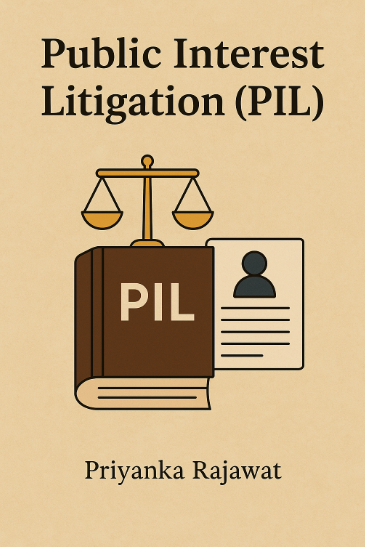
Author: Priyanka Rajawat
Public
Interest Litigation (PIL)
Background
In many parts of society, people face
barriers preventing them from accessing justice—poverty, illiteracy, or
lack of influence. From workers facing hazardous conditions to rural
communities suffering due to industrial pollution, many suffer in silence.
Traditional legal proceedings are often expensive and complex, discouraging the
underprivileged from seeking justice.
To tackle this inequality, the
concept of Public Interest Litigation (PIL) was introduced. PIL enables
individuals or groups to raise legal concerns on behalf of others, even if they
are not personally affected, bridging the gap between the courts and the common
citizen.
Introduction
Public Interest Litigation has
transformed how justice is accessed in democratic societies. Unlike regular
lawsuits that revolve around personal grievances, a PIL focuses on collective
issues affecting a section of the population. It empowers any concerned person
or group to represent those who lack the means or voice to defend themselves
legally.
For example, if a person sees
untreated factory waste contaminating a river that serves nearby villages, they
can approach the court through a PIL—even if they aren’t directly harmed.
Definition
of PIL
PIL refers to legal action taken for
the benefit of the public, especially for those whose rights are ignored or
violated. It allows any person—whether a lawyer, activist, or even a common
citizen—to seek judicial remedy in cases involving broader social interest.
The unique aspect of a PIL is that
the petitioner does not need to be the victim of the issue. The focus is on
addressing injustices that impact a group or the environment rather than
seeking personal gain.
Historical
Background
Public Interest Litigation gained
momentum in the United States during the civil rights movement of the 1960s,
where it was used as a tool to challenge racial inequality and promote justice.
In India, the concept evolved during
the late 1970s and early 1980s under the leadership of visionary judges like
Justice P.N. Bhagwati and Justice V.R. Krishna Iyer. Recognizing that many
citizens were unable to access courts, these judges simplified
procedures, allowing even a letter or a postcard describing a serious problem to
be treated as a PIL.
Pioneering Cases
A landmark PIL in India was
Hussainara Khatoon v. State of Bihar (1979), which brought attention to the
plight of under-trial prisoners languishing in jails for years without a trial.
The court’s intervention led to major reforms and the release of thousands of
such inmates.
Another influential case was M.C.
Mehta v. Union of India, where the court ordered measures to control pollution
in the Ganga River, setting new standards for environmental protection and
highlighting the court’s role in public welfare.
Contemporary
Applications of PIL
Public Interest Litigations have had
a significant impact in numerous areas:
1. Human Rights – Courts have
intervened through PILs to protect bonded laborers, prevent child labor, and improve
the treatment of prisoners and mentally ill individuals.
2. Environment – Several PILs have
led to environmental safeguards, including forest preservation, noise and air
pollution regulations, and bans on harmful substances.
3. Government Accountability –
Through PILs, courts have tackled corruption, demanded investigations into
custodial deaths, and promoted transparency in public offices.
4. Healthcare and Education – Courts
have directed governments to improve healthcare infrastructure, regulate fees
in private schools, and strengthen public education programs through PILs.
Filing a
PIL: Step-by-Step
The process for submitting a PIL is
designed to be accessible:
Identify the issue – The matter must
affect a larger group or society as a whole.
Collect supporting material –
Evidence such as news articles, photographs, or reports strengthens the case.
Draft the petition – It may be
formally prepared or submitted as a simple letter in serious matters.
Submit to the court – PILs can be
filed in High Courts or the Supreme Court of India.
Court review – If the issue is found
valid and urgent, the court initiates proceedings.
Significance
of PIL
PIL plays a critical role in
democratizing access to justice. It ensures that the legal system responds to the privileged, marginalized, and voiceless. Through
PILs, courts have addressed key issues of public concern, brought about policy
changes, and held authorities accountable.
Moreover, PIL encourages judicial
activism, where the courts step in to correct systemic failures and protect
constitutional rights. s.t
Concerns and
Misuse
Despite its advantages, PIL is
sometimes misused. Some people file petitions for personal publicity, political
vendettas, or to delay legal processes. These actions waste judicial time and
undermine the purpose of the PIL.
Another concern is judicial
overreach, where courts enter areas traditionally handled by the legislature or
executive. While the intention is to uphold justice, it's important to maintain
a balance between branches of government.
Conclusion
Public Interest Litigation remains a
powerful instrument for promoting fairness, equity, and justice. It provides
ordinary citizens the means to challenge wrongdoing and bring about meaningful
change—whether it’s cleaning rivers, fighting corruption, or protecting
fundamental rights.
Though there are concerns about its
misuse, when used responsibly, PIL serves as a vital check on power and a
beacon of hope for those who would otherwise remain unheard.
